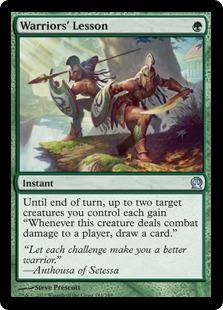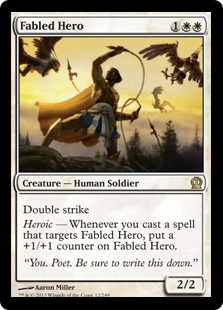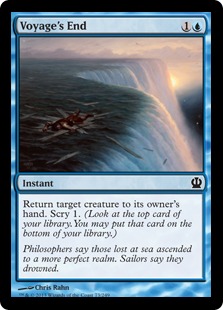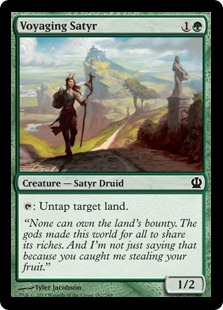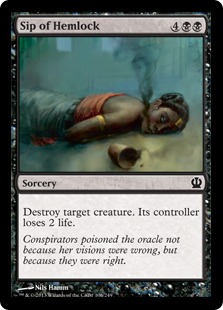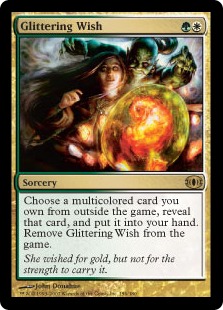A few weeks ago, Hunter and I teamed up to review every Theros common. Then, Hugh made some bold predictions about the Limited format. Finally, Hunter and Carrie, in preparation for GP Oklahoma City, chatted about green. I’d like to focus on what I’ve learned with everyone’s favorite tool: the list!
Rule #1: Have a Plan
In any game of Magic, “who’s the beatdown” or “who’s on defense” is an important question to ask and have the answer to. Theros Limited is all about knowing what role your deck wants to play. You should have this in mind when you’re building your deck, not only when you’re playing your matches. Too often I encounter black control decks running Fleshmad Steed and Tormented Hero when those creatures are too puny to protect or advance their game plan, or white heroic decks eschewing Traveling Philosophers and Cavalry Pegasus when they badly need two drops so that they can curve out with Dauntless Onslaught to be as aggressive as possible.
Decks break down to three general speeds or types: aggro/heroic (usually white or red), midrange/tempo (usually blue), or control/monstrous (usually green or black). These aren’t hard and fast rules—there can be slow red monstrous decks and midrange G/W heroic decks—but should serve as a guideline of both what you should strive to draft/build and what you should prepare for.
Rule #2: Have as many heroes as the Avengers (Aggro)
If you’re building a heroic deck, you need to have a solid curve. You can have all the tricks in the world, but if you have one or zero creatures on the battlefield, then Dauntless Onslaught does nothing (that card, while extremely powerful, is overdrafted and is put into decks too slow to benefit from it). You can have all the heroic enablers, but if you’re just tossing Chosen by Heliod on Traveling Philosopher, then you’d be better served by deploying another creature than making a Pillarfield Ox.
You should draft/build to fill out a curve so that you can use all of your mana every turn. Heroic decks can ran out of steam quickly (unless you’ve got cards like Wingsteed Rider or Vaporkin that you can power up), and they win by flooding the board and playing tricks/auras to preserve and improve that board presence. You want to max out on creatures, have a low curve, and perhaps play sixteen lands.
Also, hold on to your combat tricks! It’s tempting to use Titan’s Strength to turn Favored Hoplite into a 2/3, scry 1, and a Lava Axe on turn two, but unless you’ve got enough pump/burn in hand to put the game away (and can deal with your favorite wittle hoplite dying), then save the trick until your opponent blocks or attempts to use a Last Breath for the full blowout. Just keep deploying threats until your opponent makes you respond with a trick (or your opponent’s end is in sight)—though you should shift plans if your opponent has Anger of the Gods (aka No More Heroes).
Rule #3: First-pick Voyage’s End (Tempo)
If you’re building a tempo deck, your goal is to stick a few threats and clear the way for them with removal. Cards like Scholar of Athreos and Coastline Chimera can protect you from heroic rushes and Voyage’s End (the best common removal spell in Theros) and Griptide will eliminate whatever hurdles your slower opponents will throw in your way. Your goal is to outlast the heroic decks and outrace the monstrous decks and Voyage’s End does both.
I cannot stress this enough: you should first-pick Voyage’s End. It’s Doom Blade. Bouncing an aggressive creature neuters your opponent’s board presence (particularly if you’re undoing an Ordeal or your opponent got too trigger-happy with pump spells), and aggressive decks lose if they don’t establish early board presence. Against Nessian Asp (aka public enemy number one for blue skies/tempo) and other late-game threats, Voyage’s End is a Time Walk (as your opponent needs to spend an entire turn recasting/re-monstrifying) whereas Lash of the Whip and Rage of Purphoros wouldn’t do anything.
Voyage’s End is better than Griptide because it costs two mana (and the scry is nice, too). Sure, Griptide is card-advantage neutral (if you’re not undoing some +1/+1 counters or an aura) whereas Voyage’s End is card disadvantage, but the goal of the tempo deck is to win before card advantage becomes relevant! You want to stick a few threats (like Vaporkin, Nimbus Naiad, or Wingsteed Rider) and smash while the smashing’s good. You can easily cast Vaporkin and Voyage’s End in the same turn whereas you have to spend your entire turn casting Griptide (and trading your turn for their turn isn’t good unless you managed to get solid board presence in the first three turns, which is not easy).
Rule #4: More Mana! (Monstrous/Green)
Voyaging Satyr is the best green common. Period.
Green is slow. Sure, green’s got Nessian Courser as a threat and a solid body, but you’re trying to resolve the cuddly-soft Vulpine Goliath and slightly less-cuddly Nessian Asp. You want to not be slaughtered by the Justice League before summoning your (teen) titans or repeat your turn five thrice as your creatures keep getting knocked off the edge of the world by Voyage’s End.
To win, you need mana. You need Voyaging Satyr, Karametra’s Acolyte, and Burnished Hart to accelerate your mana. You need them more than you need almost any particular beastie. You need to hit your land drop every turn for the first five turns. You should probably be playing eighteen or nineteen lands. You should be able to laugh as they bounce your Nessian Asp, then untap and play two of them.
Rule #5: Only have a Sip of Hemlock (Black)
Black exists in an awkward space. It has a few aggressive creatures, but they’re worse and less numerous than white, red, and blue’s. It has plenty of removal, except it’s clunky and expensive. It has a sweet monoblack devotion deck but monoblack has hard time stabilizing against aggro or stopping monstrous. Don’t get me wrong, I think that black’s a god a lot going for it, but peoples’ card evaluations seem a bit off, and the most egregious deck-ruiner seems to be Sip of Hemlock.
I’ve seen draft decks with four copies of Sip of Hemlock in the main and that never go to the sideboard. They lose often and horribly. The power to kill any creature, without restrictions, is an awesome one indeed; however, when it costs significantly more mana to kill the creature than it did to cast the creature, then ’tis not so awesome an execution of said power. In other words, Sip of Hemlock is a weak removal spell. It’s too slow to interact with heroic decks and usually too slow to stop tempo decks. It shines against bombs and giant monstrous creatures, but those are only situations where it’s good. You’ll be happy to have one or two in your main deck, but you shouldn’t draft them highly and you should sideboard them out when they’re bad.
If you’re going to go heavy black, slam every Gray Merchant of Asphodel (the best black common and the only one that you want to overload on) and every powerful uncommon and rare that you see. You’ll be rewarded by late Lash of the Whip and Sip of Hemlock (once people realize that you can’t draft four each of ’em and play “kill ’em all”). It’s more important that you pick up your win conditions and bombs than you pick up awkward removal spells (which black has plenty of).
Rule #6: Sideboard Smarter
In a game of rock-paper-scissors, if you know that your opponent is about to throw nothing but scissors, you should only throw rocks. Likewise, in a rock-paper-scissors format like Theros, if you’re playing against scissors, you should remove all paper from your deck. Remember the following: aggro > monstrous > tempo > aggro. Aggro beats monstrous, because it’s too fast for monstrous. Monstrous because tempo, because its creatures stop tempo’s in their tracks. Tempo stops aggro, because it slows the game down.
Hypothetical situation: in round one of a Theros draft, your blue tempo/skies deck smashes blue/white heroic/skies thanks to Coastline Chimera brick walling your opponent’s offense. You even sided in an extra copy for game two. In round two, you’re paired up against red/green monstrous. After game one, you should probably take all of those game-winning chimeras out for cheaper threats. They’re neither applying pressure nor fending off a swarm of Voyaging Satyrs. Coastline Chimera is great against aggro, fine against tempo, and bad against giant monsters. Draft and sideboard accordingly. Too often people leave in Sip of Hemlock postboard against RW heroic, Vaporkin against Coastline Chimera deck, or Horizon Scholar against Nessian Asps.
Know what your bad matchups are, and when you find yourself in one, sideboard to make your deck act like what your opponent’s deck is weak to. If you’re playing tempo against monstrous, trim your top end and play a faster game (Vaporkin becomes better than Horizon Scholar and Prescient Chimera). If you’re playing aggro against tempo, side out your more fragile enchantments and creatures and bring out the big guns (or hope that you can execute on your plan blindingly fast). If you’re playing playing monstrous against aggro, side out some of your top end for cheaper cards.
Granted, it’s also easy to overcompensate. Siding in Fleshmad Steed against a heroic deck full of tricks is begging to have your horse trade for a Titan’s Strength (while also giving your opponent a card off of Triton Fortune Hunter). Sideboarding is a balancing act, as is playing around combat tricks.
There are no hard and fast rules, but you should always be aware of what your deck does, what your opponent’s deck does, and how that affects your matchup. When you can do that, you should be winning a lot more often than not.
Standard Pauper Tournament – Final Round!
Seven weeks down, only one left to go. By this time next week, we’ll have our top eight. Our championship in flux, as there are ten obvious contenders for top eight and in the ensuing chaos, it’s entirely possible that several X-2 players will make it. Only time will tell who proves victorious and claims my Taiga! Until then, we’ve got participation prizes! And since it’s our penultimate week (and last week’s cube bounty), I’ve doubled the number of participation prices!
- Matt LaZer wins a booster pack of Ravnica: City of Guilds!
- David Wills wins a booster pack of Guildpact and a foil Hammerfist Giant for beating Hipster’s own Rich!
- Steven wins a booster pack of Dissension!
- John Mason wins a booster pack from gwyned, who has graciously been matching my prizes and covering the entire event! Check his stuff out, it’s great!
Stay tuned, folks, ’cause top eight’s just around the corner. Here are pairings for the final round of the swiss portion.
Round 8 Pairings/Standings
[table width=”580″ align=”center”] Player One, Points, vs, Player Two, Points, Results,
P. Dalton, (18 pts), vs, Charlie S, (19 pts), (1-1)
Jason Gray, (18 pts), vs, Conor Moran, (19 pts), (1-1)
Hugh Kramer, (18 pts), vs, Justin Beckert, (18 pts), (1-1)
Andrzej “Onion” K, (18 pts), vs, Ben H, (18 pts), (2-1)
Andrew, (16 pts), vs, aceracerff, (16 pts), (0-2)
The_Sir, (15 pts), vs, Colin, (15 pts), (0-2)
Benito, (15 pts), vs, Kevin Roman, (15 pts), (2-0)
Zachary Barash (HotC), (15 pts), vs, Jesse S, (15 pts), (0-2)
Adam Bloom, (15 pts), vs, Tom, (15 pts), (1-2)
rbernardinello, (15 pts), vs, Lacio, (15 pts), (0-2)
Tim Akpinar (HotC), (15 pts), vs, MattLaZer, (15 pts), (2-1)
Kyle S, (13 pts), vs, Mrdarby, (13 pts), (1-1)
Edmilson, (12 pts), vs, David Wills, (13 pts), (1-1)
joekewwl, (12 pts), vs, Ahniwa Ferrari, (12 pts), (2-0)
gwyned, (12 pts), vs, Will, (12 pts), (0-2)
Nico, (12 pts), vs, Rich Stein (HotC), (12 pts), (1-1)
Grao, (12 pts), vs, James J, (12 pts), (2-1)
King Xia, (12 pts), vs, ElPolloLoco, (12 pts), (0-2)
togepi258, (12 pts), vs, MattP81, (10 pts), (1-1)
Hans, (10 pts), vs, Steven, (9 pts), (1-1)
James Bathurst, (9 pts), vs, bacon_music_love, (9 pts), (0-2)
Dana, (9 pts), vs, John Mason, (9 pts), (1-1)
Daniel Gardner, (9 pts), vs, ShiratoKai, (6 pts), (1-1)
Jamie B, (6 pts), vs, — Bye — [/table]
Please drop me a line in the comments or e-mail me if you’ve question, comments, debates, or anything else. As always, thanks for reading!
—Zachary Barash
twitch.tv/ZennithGP Join the livestream!
Magic Online username: Zennith
Zachary Barash has been playing Magic on and off since 1994. He loves Limited and drafts every available format (including several that aren’t entirely meant to be drafted). He’s a proud Cube owner and performer, improvising entire musicals every week with his team, Petting Zoo. Zach has an obsession with Indian food that borders on being unhealthy.

